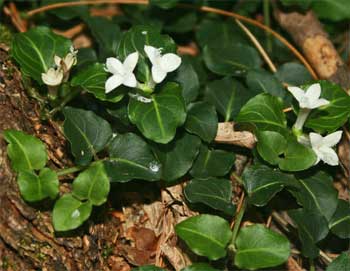Contents:
Common Names | Parts Usually Used | Plant(s) & Culture | Where Found | Medicinal Properties
Uses | Formulas or Dosages | Bibliography
Scientific Names

- Mitchella repens L.
- Rubiaceae
- Madder family
Common Names
- Checkerberry
- Deerberry
- Hive vine
- One-berry
- One-berry leaves
- Partridgeberry
- Squawberry
- Twin-berry
- Winter clover
Parts Usually Used
Leaves
Back to Top
Description of Plant(s) and Culture
Squaw vine is a perennial, evergreen herb; its creeping or trailing stems grow up to a foot long, rooting at various points, and bear opposite, orbicular-ovate (heart-shaped 1/2 to 3/4 inches long) leaves that are dark green and shining on top and are often streaked with white. The funnel-shaped white (or pink) flowers, 1/2 inch long, grow in four-parted, terminal pairs from April to July. The inner lobes of the trumpet-shaped, paired flowers are hairy. The fruit is scarlet berry-like drupe up to 1/3 inch in diameter in the fall. Each flower produces this single dry berry usually contains 8 bony seeds that lasts over the winter.
Back to Top
Where Found
Found around the bottoms of trees and stumps in woodlands from Nova Scotia to Ontario and southward to Florida and Texas. Also found in Guatemala.
Back to Top
Medicinal Properties
Astringent, diuretic, tonic, restorative, uterine stimulant, parturient
Back to Top
Uses
According to Native Americans, squaw vine was recommended as a drink to be taken during the last few weeks of pregnancy to make childbirth faster and easier. Used for delayed, irregular, or painful menses. As a diuretic it is used for gravel and urinary ailments. For external use, the tea makes a good wash for sore eyes, and for skin problems, swellings, hives, arthritis, rheumatism, gonorrhea, and sore nipples (add a little olive oil or cream). As an astringent, used for piles, dysentery, diarrhea. One Native American tribe drank the tea to relieve insomnia. Also taken as a spring tonic.
Back to Top
Formulas or Dosages
For childbirth preparation: take 1 cup infusion a day in the last 2 months of pregnancy.
Infusion: steep 1 tsp. leaves in 1 cup water for 30 minutes. Take 1 to 3 cups a day.
Decoction: use 2 oz. herb in 1 pint of water and take in wineglass doses.
Tincture: as a tonic, take 5-15 drops, 3 times a day.
Back to Top
Bibliography
![]() Back to Eden
Back to Eden, by Jethro Kloss; Back to Eden Publishing Co., Loma Linda, CA 92354, Original copyright 1939, revised edition 1994
![]() The Herbalist Almanac
The Herbalist Almanac, by Clarence Meyer, Meyerbooks, publisher, PO Box 427, Glenwood, Illinois 60425, copyright 1988, fifth printing, 1994
![]() The Herb Book
The Herb Book, by John Lust, Bantam Books, 666 Fifth Avenue, New York, NY. copyright 1974.
![]() Eastern/Central Medicinal Plants
Eastern/Central Medicinal Plants, by Steven Foster and James A. Duke., Houghton Mifflin Company, 215 Park Avenue South, New York, NY 10000
![]() Planetary Herbology
Planetary Herbology, by Michael Tierra, C.A., N.D., O.M.D., Lotus Press, PO Box 325, Twin Lakes. WI 53181., Copyright 1988, published 1992
![]() The Complete Medicinal Herbal
The Complete Medicinal Herbal, by Penelope Ody, Dorling Kindersley, Inc, 232 Madison Avenue, New York, NY 10016, First American Edition, copyright 1993
![]() Indian Herbalogy of North America
Indian Herbalogy of North America, by Alma R. Hutchens, Shambala Publications, Inc., Horticultural Hall, 300 Massachusetts Avenue, Boston, Massachusetts 02115, 1973
![]() American Folk Medicine
American Folk Medicine, by Clarence Meyer, Meyerbooks, publisher, PO Box 427, Glenwood, Illinois 60425, 1973
![]() Webster’s New World Dictionary
Webster’s New World Dictionary, Third College Edition, Victoria Neufeldt, Editor in Chief, New World Dictionaries: A Division of Simon & Schuster, Inc., 15 Columbus Circle, New York, NY 10023
![]() The Yoga of Herbs: An Ayurvedic Guide to Herbal Medicine
The Yoga of Herbs: An Ayurvedic Guide to Herbal Medicine, by Dr. David Frawley & Dr. Vasant Lad, Lotus Press, Twin Lakes, Wisconsin, Second edition, 1988.
 The Rodale Herb Book: How to Use, Grow, and Buy Nature’s Miracle Plants (An Organic gardening and farming book)
The Rodale Herb Book: How to Use, Grow, and Buy Nature’s Miracle Plants (An Organic gardening and farming book), edited by William H. Hylton, Rodale Press, Inc. Emmaus, PA, 18049., 1974
